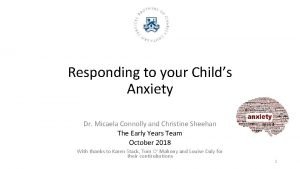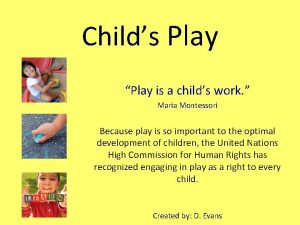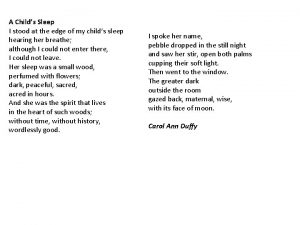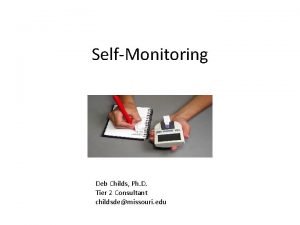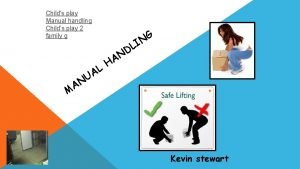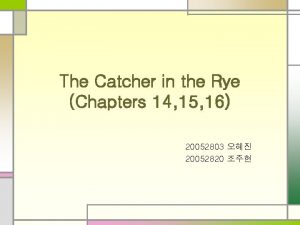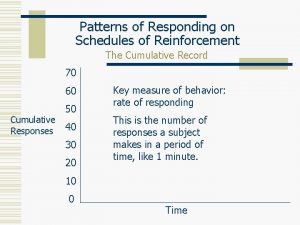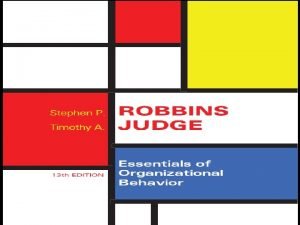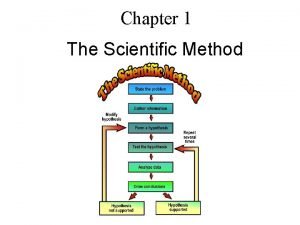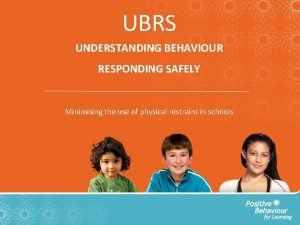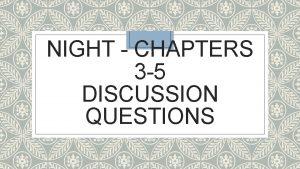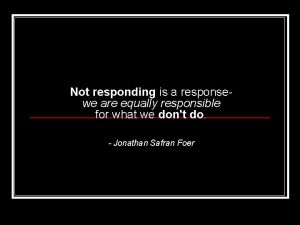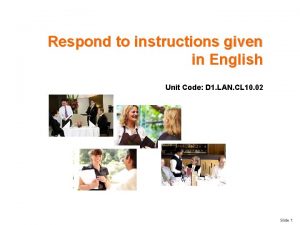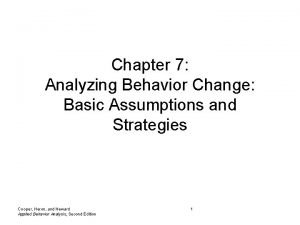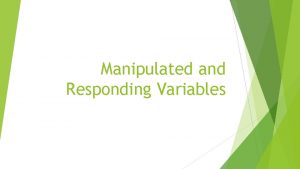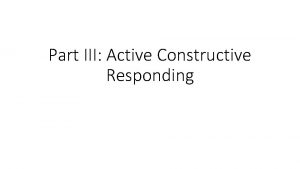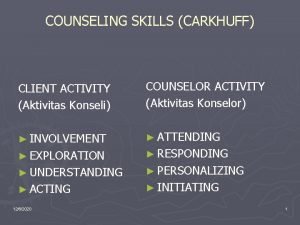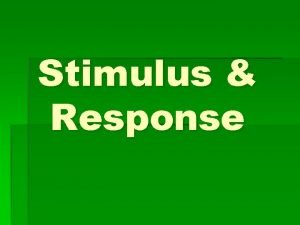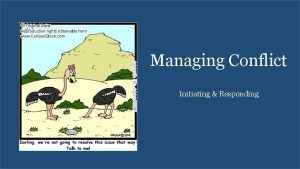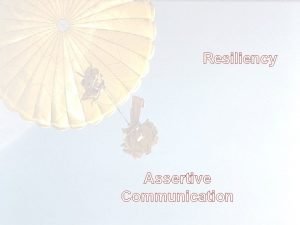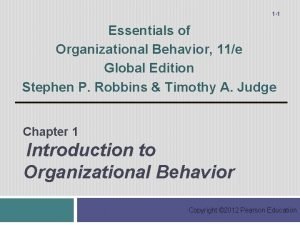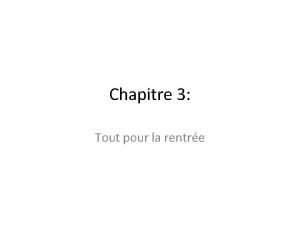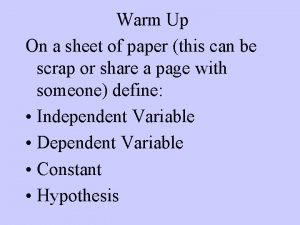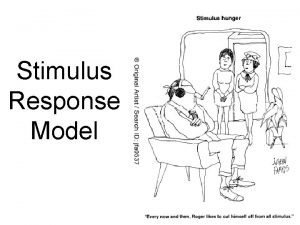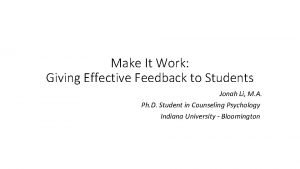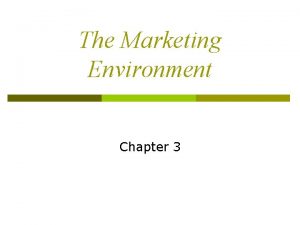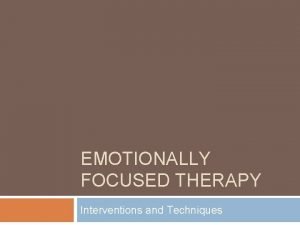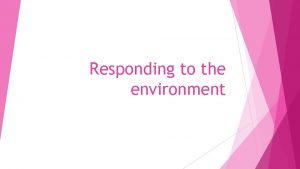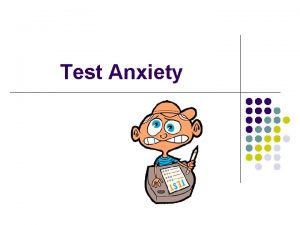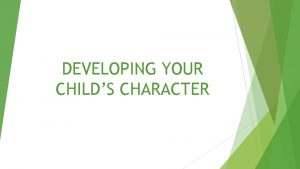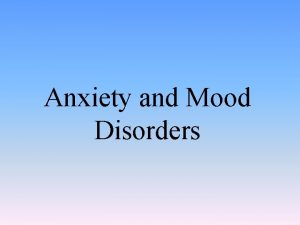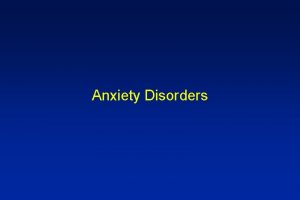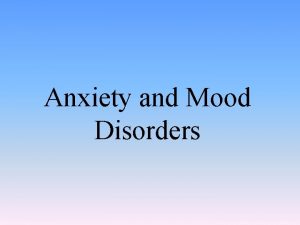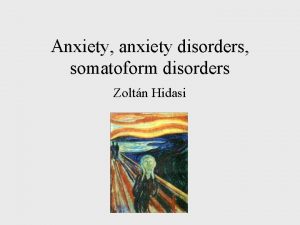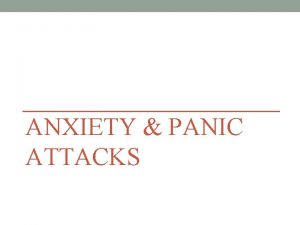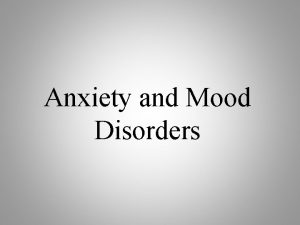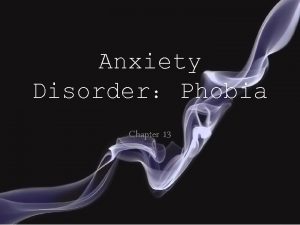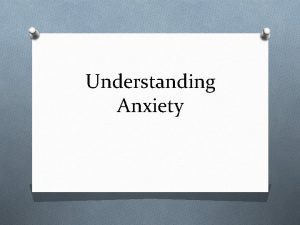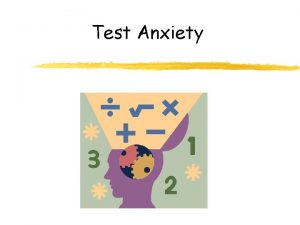Responding to your Childs Anxiety Dr Micaela Connolly



































































- Slides: 67

Responding to your Child’s Anxiety Dr. Micaela Connolly and Christine Sheehan The Early Years Team October 2018 With thanks to Karen Stack, Tom O’ Mahony and Louise Daly for their contirubutions 1

Outline for today: 1) 2) 3) Reflection at start around your own anxiety and goal for yourself (10 mins) To increase your understanding of emotional development in children with autism, with particular reference to anxiety To increase your understanding of anxiety and how it presents in your child 4) Coffee! (10 mins) 5) To explore strategies to help your children develop their emotional awareness and regulation; and for managing and responding to their anxiety Set a goal to include one thing you’re going to try over the next fortnight (10 mins) Resources Questions 6) 7) 8) 2

Goal setting How would you like this workshop to be of help • to you? • to your child? 3

Putting Maslow into practice Start with the basics….

The 24 Hour Child

Feelings and emotions • Emotions – the whole body response to things that happen • Feelings – mental reactions to emotions • Mood – moods are less specific, less intense and less likely to be provoked by a particular trigger or event

Feelings/ Thoughts / Behaviour Cycle

How do we experience anxiety?

Feelings/ Thoughts / Behaviour Cycle Levels of awareness of how behaviour impacts on others Social understanding Ability to ask for help Temperament Outside / inside influences and triggers Emotional/ feelings Environmental influences Physical / sensory Behaviour Mental/ thoughts Interpretation of an event Interpreting bodily signals Levels of comfort and control Personal beliefs, theory of mind

Internal factors • Child is hungry, tired, sick • Child doesn’t want to use toilet in school • Child is experiencing a high level of stress • Child doesn’t know what is wrong and can’t tell

External factors • Things are confusing • Sensory – things are too loud, too bright, etc. for too long • Person has reached sensory threshold • Too many demands

Sensory processing and modulation • Thresholds • A lot feels like a little • A little feels like a lot • Our sensory responses are not in check

Social communication • Child can’t ask for help • Child doesn’t have language for feelings or states • Child doesn’t communicate feelings or needs

Interpretation / Perspective • Emotion when you see a dog • Memory of being with dogs • What dog? • Where it is • What you are doing • What dog is doing • Are you wearing white trousers?

Theory of mind • Child may think you know what they are feeling and thinking • Child may not know others can help them • They may not know others have different feelings and different thoughts • They may not understand their feelings

Emotional regulation Put strategy into practice – know how to deal with feelings, know how to deal with other people’s feelings Know how to respond to the feeling and know how feelings affect others Be able to grade the feeling – is it big or small – is it appropriate to the situation? Know about the emotion – know what feelings are, recognise the feeling (body, thoughts, mood/feeling)

Emotional regulation and ASD • People with ASD can have difficulty identifying feelings • High levels of stress make it more difficult to regulate feelings • Triggers – big life stresses and daily hassles • Stress levels take time to come down • Children with ASD may be stressed a lot of the time *

Anxiety is Normal 18

Anxiety can be exciting…. 19

Body Clues 20

Your Child’s Anxiety • Let’s review our diary 21

• Too much anxiety is like your worst enemy. If your brain was like a computer, too much anxiety would be like a virus taking over and causing it to crash! • When anxious your child might: • • Avoid other people Insist on following the same routine Ask the same questions over and over again Pace up and down Hit out Want to stay near their parents Give out to themselves 22

Iceberg…

Pre-Emptive Strategies to Support Your Child’s Anxiety • The Environment • Structure • Visuals • Predictability • Timer • Breaks • Sensory Strategies • Speak Positively!!! • https: //southleeasd. wordpress. com/ 24

Strategies Thinking strategies (Top down) Calming / alerting strategies Sensory Supports (Bottom up)

1. Thinking Strategies • Thinking Strategies : Understanding feelings; big vs. little problem ; Inner coach vs. inner critic ; Super flex vs. rock brain thinking Zones of Regulation 26

Inner Coach versus Inner Critic • Exploring positive / self-help thoughts • Exploring negative thoughts Problem solving / Thinking Strategies

Key information for Thinking Strategies • Knowing it’s normal • Knowing this won’t last forever • Knowing others can help me • Knowing about feelings leads to feeling in control

How feelings work … • We can feel them in • We can grade them our bodies • We can learn to • We can have thoughts manage big feelings over little things about them • We can have feelings • We can learn about our own feelings and about them others

• • • What are feelings? Why do we have them? Everyone has them They are normal They can be pleasant They can be unpleasant • They are automatic they just happen • We can learn to understand them • We can learn how they work • We can learn to manage feelings • They are there for a • reason

Charting feelings and sensations • Teach the child body parts • Check if they know when they are hungry, tired, sad, etc. • Teach them how to read their own body states • Model your own

Social Stories & Comic Strip Conversations • https: //southleeasd. wordpress. com/

Positive Self-Statements for Coping with Anxiety • What are the alternative thoughts • Importance of self talk – child may need to be encouraged to say it out loud or under their breath until it is believed

Externalise the Anxiety 34

Structure and Visuals

Adults use visual supports all the time.


Routine, Predicatability and Motivation 38

The importance of mapping language onto Emotions • “By naming emotions we make sense of our experience. We get consolation when our emotions are recognisable in someone else. We can identify with each other and relate to one another” -Tiffany Watt Smith

By having a name for an emotion we can deal with it better.

Supporting emotional regulation in the moment PALM PAUSE Give yourself a moment to think before you respond. ATTUNE Tune in. How is the person feeling? Why might that be? LABEL Name how you think the person is feeling e. g. ‘John’s happy’ or ‘I think you’re getting bored MODEL and/or MODIFY Model a word, sign or symbol that would be useful re you respond. ATTUNE Tune in. How is the person feeling? Why might that be? LABEL Name how you think the person is feeling e. g. ‘John’s happy’ or ‘I think you’re getting bored MODEL and/or MODIFY

Emotion Keyrings


2. Calming strategies

Calming Toolkit • What do you think your child would like in theirs? 45

3. Sensory Strategies • Sensory Supports : e. g. carry, pull, swing, hug, animal walks, squishes, walk, jumping jacks etc. ( depending on equipment, space and child’s sensory profile) 46

• Sensory diets / sensory circuits

Interoception • Kelly Mahler • https: //www. mahlerautism. com/interoception

What Parents can do. . . 49

External factors • Look at triggers in the environment • Put supports in the environment (visuals, access to sensory strategies, etc. ) Internal factors • Consider sensory needs • Build up body awareness and communication skills • Teach child language for feelings / states • Name them for the child as they’re happening

Social communication • Teach how to ask for help • Teach them how to communicate their needs and wants Theory of Mind • Teach perspectives • Teach them other people have the same / different thoughts and feelings

Social Understanding Teach the child ➢how to read other people’s faces ➢other people can have different feelings /Zones ➢Teach that their behaviour can change and affect other’s thoughts, feelings and zones ➢how one’s behaviour is viewed by others ➢that people may have different perspectives and opinions that this is ok. There is not always a ‘black and white’ way of looking at things.

Anxiety and ASD See tipsheet 53

• Teach plan A and plan B- Changes happen so it’s about making it more predictable • Keep note of victories, we typically only focus on things that went wrong • An I Can! • Moment of Moments Scrapbook • Strengths cards/Shields/ Boardgames 54

Introduce ‘positive’ activities • Relaxation strategies such as yoga, deep breathing, progressive muscle relaxation • Mindfulness • Sports and physical activity • Time for special interests

56


Teaching the Zones • Is my child ready to use the Zones? • What level should I start?

Teaching the Zones • Comment on the child’s feelings at any given time, reflecting on what feeling you think they are having / what zone you think they are in.

Some Tips 60

Reactive Strategies: What to do on the spot? 61

Specific Fears • Social Stories • Remove or reduce source • Gradual Desensitisation • Information giving- weighing up the logic 62

Resources and some Book Suggestions • • The Zones of Regulation – Leah M. Kuypers www. zonesofregulation. com The Incredible 5 -Point Scale – Kari Dunn Buron www. 5 pointscale. com The National Autistic Society (NAS) website www. autism. org. uk South Lee ASD Blog https: //southleeasd. wordpress. com/ Beating Anxiety by Davida Hartman ASD Survival Guide for Kids and their Parents by Elizabeth Verdick What to do When You Worry Too Much, by Dawn Huebner Starving the Anxiety Gremlin www. thebookdepository. com

Resources • The Way I feel ( Janen Cain, 2000) • On Monday when it rained (Cherry Kachenmeister) • The Red Beast by K I Al-Ghani (Controlling Anger in Children with Asperger's Syndrome) • Finding Nemo ( Disney, 2003) • When my worries get too big (Kari Dunn Buron) • * Rath, T. , Reckmeyer, M. and Manning, M. (2009). How Full is Your Bucket? For Kids. Gallup Press • * www. sensationalkids. ie www. sensorysmarts. com Information on helping a child with sensory issues

Goal/Take home message 65

• Follow up session scheduled for 26/04/2018 66

THANK YOU
 Southleeasd
Southleeasd Childs work childs play
Childs work childs play Connolly lodge buckingham street
Connolly lodge buckingham street Fundamentals of web development randy connolly ppt
Fundamentals of web development randy connolly ppt Connolly & hickey historical architects
Connolly & hickey historical architects Clare partridge
Clare partridge Sucheta connolly md
Sucheta connolly md Connolly recovery audit
Connolly recovery audit Kanika kitchlu-connolly
Kanika kitchlu-connolly Micaela capobianco
Micaela capobianco Allografo cos'è
Allografo cos'è Micaela vernmark
Micaela vernmark Micaela capobianco
Micaela capobianco Micaela lattanzio
Micaela lattanzio Gretchen childs
Gretchen childs Naughtia childs
Naughtia childs A childs sleep poem
A childs sleep poem Heather childs
Heather childs Karyn l childs
Karyn l childs Deb childs
Deb childs Manual handling childs play
Manual handling childs play Heather rawls
Heather rawls Chapter 15 catcher in the rye
Chapter 15 catcher in the rye Aaets
Aaets Kenna childs wikipedia
Kenna childs wikipedia Gretchen childs
Gretchen childs Mdcalc childs pugh
Mdcalc childs pugh Dee childs
Dee childs Scalloped pattern of responding
Scalloped pattern of responding Responding to economic pressures
Responding to economic pressures Scientific method manipulated and responding variables
Scientific method manipulated and responding variables Understanding behaviour responding safely
Understanding behaviour responding safely Night three never surrender discussion questions
Night three never surrender discussion questions Not responding is a response
Not responding is a response How to respond to instructions
How to respond to instructions Paraverbal communication cpi
Paraverbal communication cpi Why are line graphs powerful tools in science
Why are line graphs powerful tools in science Alternate angles
Alternate angles Example of affective objectives
Example of affective objectives Affirmation of the consequent aba
Affirmation of the consequent aba How companies react to the marketing environment
How companies react to the marketing environment Manipulated and responding variables worksheet
Manipulated and responding variables worksheet Responding to globalization in ob
Responding to globalization in ob Active constructive responding
Active constructive responding Attending responding personalizing initiating
Attending responding personalizing initiating Evidence crime scene
Evidence crime scene Responding to internal stimuli
Responding to internal stimuli Initiating conflict
Initiating conflict Active constructive responding
Active constructive responding Complementing intuition with systematic study
Complementing intuition with systematic study Responding to internal stimuli
Responding to internal stimuli Action verbs for affective domain
Action verbs for affective domain Responding to the marketing environment
Responding to the marketing environment Making and responding to requests 2 bac
Making and responding to requests 2 bac Expression of congratulating
Expression of congratulating Manipulated variable and responding variable graph
Manipulated variable and responding variable graph Stimulus response chart
Stimulus response chart Pulmonary score
Pulmonary score Losada ratio
Losada ratio How companies react to the marketing environment
How companies react to the marketing environment Eft cycle
Eft cycle Responding to the environment
Responding to the environment An indirect, dishonest way to control or influence others
An indirect, dishonest way to control or influence others Give us your hungry your tired your poor
Give us your hungry your tired your poor Hydroxyzine pam 50 mg cap for anxiety
Hydroxyzine pam 50 mg cap for anxiety Anxiety symptoms
Anxiety symptoms Warning signs of anxiety
Warning signs of anxiety Stai adalah
Stai adalah
